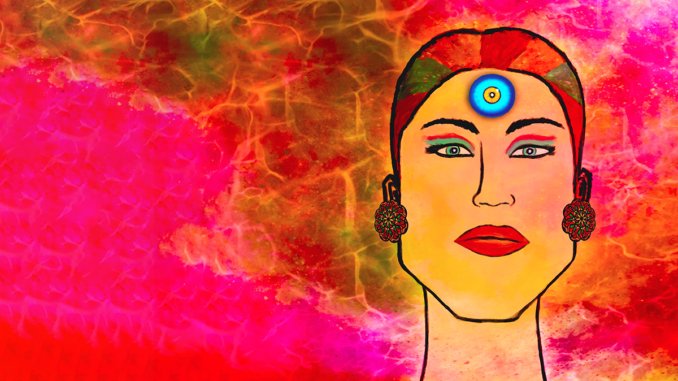
Here’s an intriguing question: Why do our bodies, and those of other mammals, produce N,N-Dimethyltryptamine (DMT), a potent psychedelic also found throughout the plant kingdom? The answer, perhaps disappointingly, is that we still don’t know. According to the authors of a new review in the Journal of Psychopharmacology,1 DMT’s raison d’etre – indeed whether or not it’s relevant to mammalian physiology at all – is the subject of a 60-year debate that remains unsettled to this day.
Instead of rehashing the entire history, which the review authors assert began in 1961 with a claim in the journal Science that endogenous DMT could underlie mental illness,2 let’s jump to 2001. When Rick Strassman’s landmark book DMT: The Spirit Molecule was published that year, DMT was still a niche subject in a niche field. In 2001, only six papers across the entire body of peer-reviewed scientific literature so much as mentioned the compound – five of which, including one coauthored by Strassman,3 were concerned with research methods and pharmacology. (The sixth was an early and now widely cited study out of Europe on the subjective effects of the psychedelic brew ayahuasca, which contains DMT.4)
Strassman posited that DMT generated in the pineal gland plays a key role in near-death and mystical experiences.
Stateside, Strassman’s studies in the 1990s into the peculiar, powerful effects of pure DMT administered intravenously to healthy human volunteers at the University of New Mexico represented the first government-approved research into psychedelic drugs in more than two decades. But even beyond that, his book, informed by these groundbreaking studies, reignited the debate over the role of endogenous DMT in humans by proffering some rather provocative theories involving the pineal gland, considered by some to be a “third eye” or seat of the soul.5
In particular, Strassman posited that DMT generated in the pineal gland – a tiny gland the size of a grain of rice deep within the brain that produces melatonin, a structural analog of DMT – plays a key role in near-death and similar mystical experiences. Many of the dozens of DMT trips cataloged in Strassman’s studies include features also common to previously reported near-death experiences.
Second Thoughts about a Third Eye
Following the publication of DMT: The Spirit Molecule (and, later, the release of a documentary co-produced by Strassman and starring Joe Rogan), this line of thinking became “a hot topic in countercultural pseudoscience,” write the authors of the new review, both of Spain’s ICEERS Foundation (International Center for Ethnobotanical Education, Research and Services). But they then proceed to throw cold water on Strassman’s theory by citing research led by another major figure in psychedelic science, David Nichols, who published a paper in 20186 “exposing the numerous difficulties that the pineal gland [would] have to face in order to produce fully psychoactive amounts of DMT in the few seconds or minutes before death.”
Complicating things further, the review authors also reference a 2019 study in Nature7 that documented a doubling of extracellular DMT levels in the rat visual cortex following experimentally induced cardiac arrest – both with and without an intact pineal gland – suggesting a link between stressful situations and endogenous DMT, but not the pineal gland.
Why else might this mysterious molecule be produced in the mammalian body at low levels? “It has been proposed that DMT is a neurotransmitter, a neuromodulator, and a neurohormone, and that it serves a protective function in peripheral tissues,” the authors write, citing evidence for each from as far back as the 1970s and as recent as the 2010s. However, they add, again citing Nichols, “other authors defend that it is not likely that DMT can play any natural role at the concentrations [at which] it has been detected.”
Ultimately, the review authors seem to land somewhat closer to Strassman than Nichols. They conclude that it’s “very likely” that endogenous DMT plays a role in some aspect of mammalian physiology – perhaps related to consciousness or dreaming, they speculate – and assert that “the time has come to prove it.”
Current DMT Research
Despite popular interest and a prolonged debate over the function of endogenous DMT, current research into the compound is focused on its use as a psychedelic drug, both as a component of ayahuasca and on its own, typically smoked or vaporized. But the two research aims need not be siloed. After all, it was the study of cannabis that led to the discovery (and naming) of endocannabinoids and the broader endocannabinoid system, which in turn continues to inform the use of cannabis and cannabinoids to therapeutic ends.
Or, in another example offered by the authors, opiates helped us to better understand pain, which can in turn help us to better use opiates. Similarly, they write, “our knowledge about psychedelic drugs will improve substantially if we understand the natural mechanisms with which they interact.”
To take things one step further for both cannabis and DMT, if endogenous counterparts of Schedule 1 substances “are at the heart of important aspects of being human,” they write, then that’s cause enough to reconsider our legal, political, and philosophical perspectives on these drugs.
Nate Seltenrich, an independent science journalist based in the San Francisco Bay Area, covers a wide range of subjects including environmental health, neuroscience, and pharmacology. Copyright, Project CBD. May not be reprinted without permission.
Footnotes



Be the first to comment